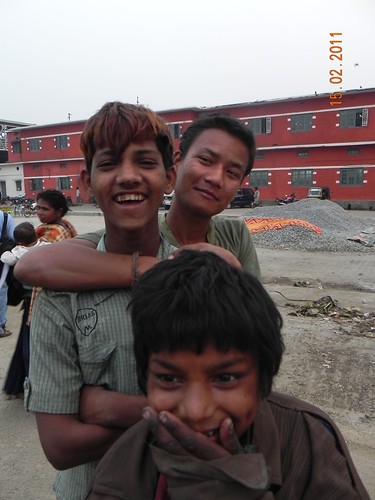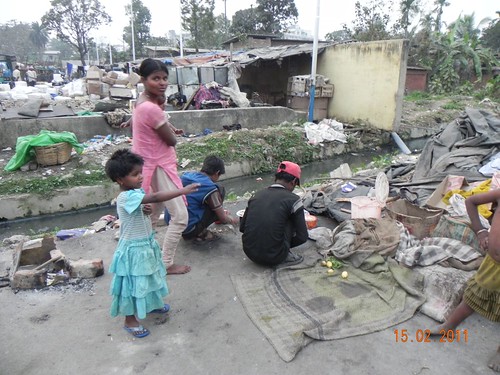By Anjuman Ara Begum, TwoCircles.net,
The homeless, people without shelter, are often denied their dignity as Human Being. Homelessness accompanied by poverty forces people to live without proper shelter, house, food, child care, health care, and education. This section of people is also most vulnerable to violence by any muscle power. Media reports of a growing economy and low unemployment mask a number of important reasons why homelessness persists.
At a visit to a health camp near Guwahati railway station organized for the homeless people of Guwahati organized by sSTEP (Society for Social Transformation & Environment Protection) sponsored by Action Aid, Sattar Choudhury, Project coordinator (Homeless), sSTEP, informed that the camp is held for last three years on every Tuesday. About 50-60 people visit the camp where doctors attend them and medicines are made available to them free. Sometimes more than 100 visitors get medicines in this camp.

Homeless children shares a laughter on being photographed
(sSTEP) was initiated in 1998 and is continuing its timely interventions in the areas of most marginalized people with the objective to create a society where the rights of every person, which is guaranteed by the constitution, is upheld. It focuses especially on urban poor in Guwahati city and we have been working with street children, homeless, unorganized labour, street vendors and domestic workers since 2003 to provide care and protection through informal education, health care, emergencies support and recreational activities. Over the years sSTEP has been involved in Awareness on livelihood, Shelter rights, sharing & motivational meeting, motivational trips and has initiated unionization in the form of homeless labour under a committee named as ‘Padapath Nibashi Banchita Committee’, Sukreswarghat and Ulubari.
For the simple understanding ‘homelessness means the absence of a place to live (a house or apartment or room – the physical structure) – which includes the absence of belonging to a place and the people living there (a home, in the social/psychological sense)’. Simply anyone who doesn’t possess a fixed, regular, and adequate nighttime residence is considered as homeless.
A report says that in India, 25% of the country’s poor live in urban areas and 31% of the urban population is poor and is expected to grow to almost near 50% by 2030 .Traditional rural-urban migration exists in India as villagers seek to improve opportunities and lifestyles. In 1991, 39 million people migrated in rural-urban patterns of which 54% were female. Caste and tribe systems complicate these population movements.
In Guwahati, ‘the population of homeless is not a fixed number. It varies from time to time over the years’, said Sattar Choudhury. He said that ‘during our observation we have come with the viewpoint that due to social, economic and psycho physical reasons they have left their native place and family and came to Guwahati for livelihood opportunities and compelled to take shelter on the pavements, premises of Government and Non Government Institutions situated on the road side as well as beneath trees’. They are often “cleared’ from the streets by the authorities, especially during visits by VIPs, on the ground that they indulge in activities which are ‘criminal in nature’.
Age group
The age group of the shelter less shows that the highest percentage of about 52% of them is in the age group from 26-45.This group of population could be rehabilited through an integrated livelihood support programme. But the major issue is the higher percentage of old age shelter less in the group 46 and above, constituting about 37% and specially 8% of shelter less in age above 66 years. The deplorable condition of the destitute could not give an answer to this helpless poor.
According to a survey by sStep, in 2009 the total homeless people in Guwahati were 980 out of this male were 530, female 390, children 63, mentally challenge 9 and physically handicraft 15. Out of the total homeless 46 are mentally ill and 40 are physically challenged. In mentally ill category 19 are female and 27 are male. Most of the physically challenged are male. Figures were obtained after thorough head counting.
Homelessness causing vulnerability
People migrate from one part to another part of the country for various reasons ranging from socio-economic, political or other reason and the trend of migration is higher among the shelterless people. ‘It is seen that the highest percentage of this group of poor has migrated from Assam and Bihar. The shelter less has come from other states too like Madhya Pradesh, Meghalaya, Rajasthan, Tamil Nadu, Tripura, Uttar Pradesh, West Bengal and Nepal’. In Guwahati city, homeless people are mostly from the underdeveloped districts like Kamrup, Barpeta, Goalpara, Dhuburi, Sonitpur, Nagaon and Golaghat. The concentration of homeless population in Guwahati can be witnessed almost all over the city area though the highest number of concentration is in the Sukreswar Mandir near Panbazar, Paltanbazar, Railway Station and Lakhtakia. There are about 100 people living in and around Sukleshwar temple, about 30 of them are women. This figure includes 3-4 mentally ill, a few disabled to various degrees, 10-15 of them are suffering from various diseases. A few women have their kids along with them.
According to sStepp, ‘the other areas where these people sheltered themselves are Guwahati Club, Ulubari Fly Over, Kamakhya Gate, Bhorolumukh, Machkhowa, Bora Service, Bhangagarh, Ganeshguri Fly Over, Cherap Bhati, Fatashil Ambari, Kamakhya Station, Beltola, Kumarpara, Morachali near Stadium, Jalukbari, Khalipara Jatiya and Maligaon’.
Causes of homelessness are diverse and complicated. Various reports cited the reasons as natural disaster, ethnic conflicts, soil erosion, migration in search of jobs, social stigma towards TB, disability and mental illness. Most of the homeless people this writer interacted, however, cited domestic violence as the prime reason for leaving home and taking shelter in the streets.
Livelihood options are almost absent for the homeless. Begging seems to be the prime source of livelihood for the homeless. Some are forced to become hawkers, wage labourers, prostitutes, rickshaw puller, cart pusher, servant while some others are involved in petty trade, dead body carrying and rag picking.

“Residence” of a homeless family
‘Lives of homeless people are very vulnerable. They are exploited in every step and often harassed by police and others. They are also very carefree and ‘bindas’ as they have nothing to lose’, shared Sattar. This proved true later as a young boy burst into laughter while narrating how he lost his hand in an accident just two days ago as if he has no regret for losing a hand.
Harassment by police on suspicion is commonplace leading to additional fear and vulnerability. Raj Ali (name changed), a young homeless with his family informed that he has been arrested many times for crimes unknown to him. Each time he has to stay in the police lock up for 3-4 days and it burns his pocket. ‘I am forced to spend about 4-5 hundred rupees each time I am arrested and my wife and children are left unattended in my absence’. Sex workers too informed that they have to contantly ‘contribute’ to police to keep earning.
There are also ‘internal’ vulnerabilities. Very often they indulge into ‘friendly clashes’ among themselves. Reasons for such violence of clash can be silly. I was ‘privileged’ to witness such a silly fight. I noticed that a boy who lost one of his hand in an accident recently smelling a piece of cloth. Suspecting it to be of dendrite, I asked him to show the cloth piece. He smiled and replied, ‘didi, no smoking’. Immediately another fellow homeless person started beating him. Some onlookers intervened but both were in bloods by then. The reason behind such sudden attack became clear within minutes. ‘He never went school and never learnt English. Why he was talking in English with you?’ I realized that ‘no smoking’ is an English sentence. Instances of such ‘friendly clashes’ are also observed in other ‘sites’ of homeless population in Guwahati. Best explanation for such violent behavior could be only one element, that is, their vulnerability towards their existence.
Among all these vulnerabilities, there can be some positive rays of hope. Directorate of Census Operation, Assam is all set to conduct a census on homeless on 28 February at night. Also in response to a PIL filed in the Supreme Court on November 27, 2010, the court had directed all the State Governments in the country to take immediate necessary steps so that no life is lost due to non-availability of night shelters. It is reported that Social Welfare department along with the local NGOs is working on the implementation of the order. Civil society needs to monitor that the homeless are at least safe at night and a long term policy must be adopted to get rid of the problem.

